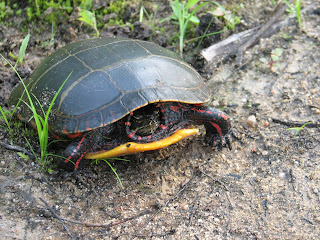 I've had enough of trying to fight the summer. Instead of fighting it, I'll just move at the speed that the summer dictates.
I've had enough of trying to fight the summer. Instead of fighting it, I'll just move at the speed that the summer dictates.I've taken the same approach with my summer birding. Instead of struggling to find the birds, I'll let them find me. On Saturday, I visited the Pine Brook Bog in East Hampton. When I first arrived, there didn't seem to be many birds around. Great Blue Herons, a few Wood Ducks, and an Eastern Phoebe were the only species to get my attention. I leaned back against my truck for a few minutes and listened to a New York sports station as the callers talked about the Yankees and Red Sox Series that is going on this weekend. That's when I noticed a big, dark, butterfly playing hopscotch across the sandy soil. I didn't come looking for butterflies but the butterfly was there. So why should I ignore it? I don't know much about butterflies but I do recall someone telling me last year that this particular species is a Spicebush Swallowtail. Feel free to correct me if I'm mistaken.
 After watching the butterfly for a while, a dragonfly landed on my antenna. I'm probably less interested in dragonflies than I am in butterflies. After all I'm looking for birds-right? The thing is, with the current heat and humidity , I was not about to go bushwhacking through the woods. At the same time I was listening to callers arguing about the Red Sox and Yankees on the radio, two dragonflies were fighting to gain position on top of my truck antenna. I'm not sure what species these dragonflies are. I think the top and bottom photo might be the same species even though they look very different because of the variation in lighting.
After watching the butterfly for a while, a dragonfly landed on my antenna. I'm probably less interested in dragonflies than I am in butterflies. After all I'm looking for birds-right? The thing is, with the current heat and humidity , I was not about to go bushwhacking through the woods. At the same time I was listening to callers arguing about the Red Sox and Yankees on the radio, two dragonflies were fighting to gain position on top of my truck antenna. I'm not sure what species these dragonflies are. I think the top and bottom photo might be the same species even though they look very different because of the variation in lighting. This one almost looks like it has a smile on its face is it happy because its summer or because it won the battle for control of the antenna?
This one almost looks like it has a smile on its face is it happy because its summer or because it won the battle for control of the antenna?  I never seem to be able to get close-up photos of Belted Kingfishers. I'm thinking that this is a male because it doesn't show the rusty orange color on the breast that the female has. Most of the time it's the males that end up with the flashy colors so Belted Kingfishers are different in that way.
I never seem to be able to get close-up photos of Belted Kingfishers. I'm thinking that this is a male because it doesn't show the rusty orange color on the breast that the female has. Most of the time it's the males that end up with the flashy colors so Belted Kingfishers are different in that way. I also made a visit to The Rocky Hill Meadows which is a series of farm fields along the Connecticut River. Unfortunately for me, the roads were flooded out from all the rain we had . For the next couple of months, the meadows are a great place to observe migrating shorebirds. I took a short walk along a nearby trail there and was scolded by a House Wren. It didn't take much convincing for me to turn around and head back to my truck.
I also made a visit to The Rocky Hill Meadows which is a series of farm fields along the Connecticut River. Unfortunately for me, the roads were flooded out from all the rain we had . For the next couple of months, the meadows are a great place to observe migrating shorebirds. I took a short walk along a nearby trail there and was scolded by a House Wren. It didn't take much convincing for me to turn around and head back to my truck. On the way back, I came across a nice patch of black raspberries. Shortly after I took this photo, the raspberries mysteriously disappeared.
On the way back, I came across a nice patch of black raspberries. Shortly after I took this photo, the raspberries mysteriously disappeared. I caught these Barn Swallows in the middle of a conversation but it looks like one of them is doing most of the talking.
















